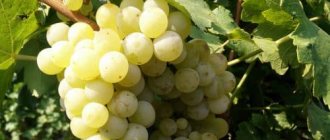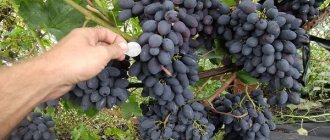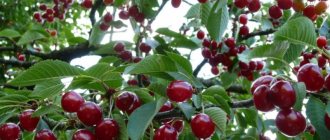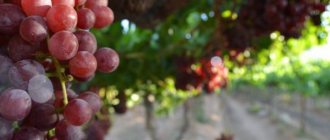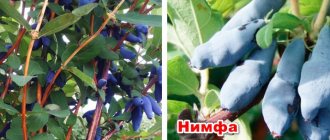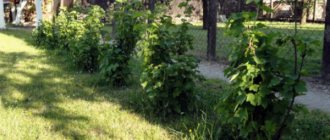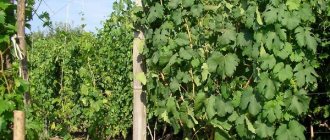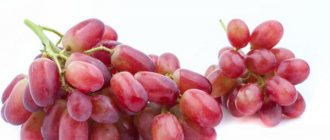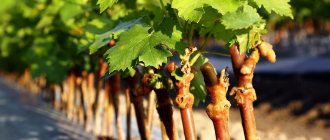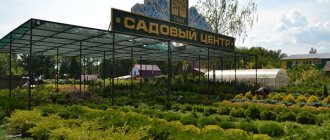Ripening time, yield and application
The harvest can begin to be harvested by the end of summer.
Note that this variety is very high-yielding and low-waste. Approximately 6 kilograms of fruit are harvested from one mature bush, and 15 tons per hectare. The fruits can be used for the following purposes:
- production of wines - dessert, table, blended;
- making homemade liqueurs, compotes;
- preparation of various kinds of sweet preserves - jams, marmalade, preserves, confitures;
- and of course, the grape harvest is very good when fresh.
We will learn further how and where to plant these grapes correctly.
Description of the variety
“Gurzufsky pink” is a table grape variety obtained about 30 years ago by crossing the “Magarach” and “Muscat VIRA” varieties. “Gurzuf pink” is considered universal, as it is equally good both fresh and as a raw material for wine, jam or juice.
The vine bush is tall and vigorous. Even under the most average weather conditions, each bush produces up to 6 kg of berries. The latter deserve special delight: the dark red berries reach large sizes and weigh up to 6 g each.
The berry contains only 3-4 seeds, the peel is dense, but tasty, and can be eaten. “Gurzufsky Rose” has virtually no waste; 90% of the grapes are recycled. As a rule, the grapes ripen by August.
The flowers of the variety are bisexual, so the grapes do not need pollination. The bushes grow very quickly and need periodic pruning.
The grape pulp is very juicy, sweet, and includes honey and nutmeg notes, giving the berries a completely indescribable taste.
Despite the fact that the variety was created for the southern regions of Ukraine and Russia, “Gurzuf Pink” can also be grown in much more northern regions. The vine easily adapts to unfavorable conditions and can withstand frosts down to -26 C.
Advantages and disadvantages of the variety
- The advantages of the plant include:
- high productivity;
- good resistance to fungal diseases;
- high frost resistance (with good shelter, bushes can withstand temperature drops down to -25...-27°C);
- early harvest ripening;
- excellent transportability and high consumer qualities.
- As for the disadvantages of the variety, it is first of all important to note:
- the need for regular pruning of bushes due to their tendency to grow rapidly;
- the possibility of rapid growth of shoots (fatification) when the vine is underloaded and liquefaction of the pulp when the vine is overloaded;
- frequent attacks by wasps, birds, ticks and grape moths.
To minimize disadvantages, you should be more attentive to the growing conditions of plants, promptly covering them from pests and protecting them from other unfavorable environmental factors.
Did you know? On average, a grapevine remains viable for 50 years, but there are cases of long-lived crops. Thus, the oldest is considered to be the vine from the “House of Wine”, which is located in the city of Maribor (Slovenia), because according to rough estimates, this plant is about 450 years old.
Properties
The most important characteristic of any grape intended for fresh consumption is taste. Delicate and unusually sweet, it is ideal for desserts and preserves when juices or jams are made from the grapes. According to the tasting scale, “Gurzuf Pink” gets 8 out of 10 possible.
However, this is not the only important characteristic of the vine.
Calorie content
The calorie content of berries depends on the amount of sugar. In general, sour varieties contain less sugar than sweet varieties, and green varieties contain less sugar than red or black varieties. The sugar content of the variety reaches 25–30%, which is quite a lot. Accordingly, the caloric content of “Gurzuf pink” reaches 75 kcal per 100 g. Read about the caloric content of Taifi grapes in this material.
The popular variety “Kishmish” has the maximum calorie content - 95 kcal per 100 g. This is facilitated not only by the high sugar content of the vine, but also by the density of the berries.
Benefits and harms
Despite the high sugar content, grapes are difficult to classify as foods undesirable when following a diet. Firstly, the same 100 g of berries contain 1.6 g of fiber. For comparison, dietary oatmeal porridge contains 8 g of fiber per 100 g of product, and 3 g in apples. Secondly, “Gurzuf pink” is a real record holder for potassium content, and this element helps remove swelling.
In addition, grapes contain a lot of other useful vitamins and microelements - phosphorus, calcium, magnesium, iron, which gives them the reputation of a real vitamin bomb:
- grapes have a clear restorative health effect and stimulate the immune system;
- the high potassium content prevents the formation of blood clots and reduces the likelihood of blockage of blood vessels;
- like any other red grape variety, “Gurzuf pink” promotes hematopoiesis and favors liver function;
- a large amount of vitamin C also provides an anti-inflammatory effect;
- Thanks to the high content of various organic acids, grapes stimulate digestion and improve appetite. These properties of grapes are so effective that different varieties of berries are prescribed for the treatment of various digestive disorders;
- “Gurzuf pink” is no less healing for various pulmonary diseases: bronchitis, asthma, and even in the first stages of tuberculosis;
- with the help of sweet red and black varieties, metabolic disorders such as uric acid diathesis and gout are treated;
- excellent taste and sugar content cause another effect: consumption of grapes helps relieve stress and normalize sleep.
Vitamin C contained in grapes stimulates the production of collagen and elastin, which quickly affects the appearance of skin and hair.
The use of grapes as medicine or disease prevention - ampelotherapy, does not exclude the use of medications prescribed by a doctor.
Grapes can also cause harm, like any product, if consumed uncontrollably. When including “Gurzuf pink” in the diet, the following factors should be taken into account:
- OLYMPUS DIGITAL CAMERA
The variety has not only high sugar content, but also acidity. People with high stomach acidity should use it very carefully;
- For patients with diabetes, it is also better not to include this variety in the menu, but to consume more sour green varieties;
- for hypertension, grapes in a trailer should be eaten in moderation, since the high potassium content forces the body to give up water, which in hot weather can provoke a crisis in a hypertensive patient;
- in case of intestinal disorders, berries are temporarily avoided, as the latter help relax the intestines;
- “Gurzuf pink”, like any other dark grape, is poor in iron. It is preferable to give green varieties to children.
Acidity
The acidity of the variety is determined by the amount of tartaric and malic acid. The remaining organic acids are present in very small quantities and are not taken into account. A person is very sensitive to acidity and is able to detect the taste even at a concentration of 1:13000. It is the ratio of sugar content and acidity that creates the unique taste of the berries, and most importantly, the wine from which it is made. Read about the Hamburg Muscat variety here.
The more tartaric acid in the berries, the tastier they are, since this substance has a soft, pleasant taste. Malic acid causes a harsh taste. It is absent in red berries, and, accordingly, in “Gurzuf Pink”.
The acidity of “Gurzuf pink” is 8 g/l. This is the average. Thanks to this, the berries remain very sweet and tender in taste, and the wine acquires honey and nutmeg notes.
French black grape – Muscat Cayaba
Black Muscat grapes are widely known as Cayaba or Kalyaba. Its origin is not known for certain, however, the first mentions of it date back to the beginning of the 19th century. It grows in warm climates mainly on the southern slopes of France, as well as on the Crimean Peninsula.
Black Muscat grapes are widely known as Cayaba or Kalyaba. Its origin is not known for certain, however, the first mentions of it date back to the beginning of the 19th century. It grows in warm climates mainly on the southern slopes of France, as well as on the Crimean Peninsula.
How to plant Muscat correctly?
Planting Muscat grapes is not very difficult - everything is the same as with an ordinary vineyard. It is necessary to dig holes for individual seedlings. If it is a seedling that is being planted, and not a cutting, then a hole is dug approximately 80x80x80 cm; if cuttings are planted, then they can be planted in rows at a distance of 1-1.5 meters from each other.
Pleven Muscat grape variety
A peg is placed in each hole - the original support of the vineyard. It is worth making 5-10 cm of drainage at the bottom, from gravel or crushed stone, but only if the groundwater level is high. Now you can make a mound out of the earth in the hole. A seedling is placed on this mound, its roots are spread well, and then gradually covered with earth. If Muscat grape cuttings are planted, they are only slightly deeper into the ground (in rows), sprinkled with earth and tied to a peg.
It is worth adding 2-3 cm of peat or humus into the circle around the trunk, but if planting was done before winter, mulching is necessary by 5-10 cm. Also, before the onset of frost, nutmeg seedlings should be covered with film or similar material. After all, young Muscat is absolutely defenseless against frost.
Planting Muscat grapes is not very difficult - everything is the same as with an ordinary vineyard. It is necessary to dig holes for individual seedlings. If it is a seedling that is being planted, and not a cutting, then a hole is dug approximately 80x80x80 cm; if cuttings are planted, then they can be planted in rows at a distance of 1-1.5 meters from each other.
The best varieties of muscat grapes - description and characteristics
Some varieties stand out from the rest. These include:
- Black.
- Pink.
- Hamburg.
- Alexandrian.
- Hungarian.
- Incense (White).
They are the most famous and are used to make the best varieties of wine. There are also many varieties of Frankincense, Black and Rose grapes. They differ in their characteristics.
White extra-early Muscat grapes have the property of increased sugar accumulation. In ripe berries, the sugar content reaches 25-30%, which allows this species to be used for the production of sweet dessert wines.
Hamburg
Hamburg Muscat is a table variety, medium late variety. The growing season is 148 days. The berries ripen in mid-September. Productivity is high, but unstable. Fruiting of shoots is 67%. The variety is grown in Russia, Hungary, Romania, Argentina, Tunisia, Greece, France, and the USA.
Medium sized bushes. In rich soils, plant growth increases. The shoots are densely leafy. The annual shoot is brown, the nodes are reddish in color. The leaves are large and of medium length. The shape is heart-shaped, deeply and moderately dissected, consists of 5 wavy lobes. The edges are corrugated.
The leaves are pubescent. Green color with bronze flecks. The cloves are wine-red. In autumn the leaves turn yellow.
The clusters are large or medium, conical, branched, loose, large. The leg is medium, grassy green. The weight of the bunch is 170-260 grams. The length reaches 20 centimeters. Width – 12-17 centimeters.
The berries are oval or round, large, and often burst when the flowers freeze. Their length is 1.3-2.6 centimeters, diameter - 1.2-1.7 centimeters. The skin is violet-blue, dense, covered with a waxy coating. The pulp is fleshy and juicy. The taste is harmonious and pleasant. The aroma is nutmeg, subtle. 1 berry contains 2-3 large seeds.
- Tasting rating on a ten-point scale: 9.1 points.
- Sugar content is 22 milliliters. Acidity 8 g/l.
- The grapes are transportable and can be stored for 2.5-3 months.
Grapes make delicious juices, marinades, compotes and jams. Disease resistance is low. The variety is heat-loving, demanding on humidity and soil.
- The variety has poor resistance to gray rot, oidium, bacterial canker, mildew, and phylloxera.
- Resistance to damage by bunch budworm is average.
- Frost resistance is weak. The bush can withstand frosts down to -19 degrees. After a cold spring, peas appear.
Due to low frost resistance, grapes need to be shaped like a double-armed Guyot. The cutting length is 4-6 eyes. The bush's load should be 18-20 shoots (of which 12 are fruitful).
In warm regions, you can use a high-standard, double-shouldered cordon formation. The height of the trunk is 1.2 meters. Pruning of shoots is shortened and depends on the integrity of the eyes after winter.
- Tasting rating on a ten-point scale: 9.1 points.
- Sugar content is 22 milliliters. Acidity 8 g/l.
- The grapes are transportable and can be stored for 2.5-3 months.
Characteristics of the bush
The grape bush is vigorous, develops very quickly, and therefore needs frequent pruning. The plant is not prone to diseases.
The height of the bush reaches 1.5 m, the leaves are bright green, dissected.
Vine
The vine is brown, with a reddish tint, with uniform nodes. It ripens even under unfavorable conditions, but in this case the ripening process extends until the end of September. Many owners of vineyards in more northern latitudes are familiar with this feature.
Bunch
The clusters are cylindrical or cone-shaped, usually medium in size. The weight of the bunch is 250–400 g. However, under favorable conditions it can reach 700 g. But, although the weight of the bunch is considered average, it is compensated by the number of them on the vine.
The berry is medium-sized, round, dark red with dense skin and fleshy-juicy pulp.
The clusters of “Gurzuf pink” are loose. This is not a drawback indicating poor pollination, but a feature of the variety.
The berries themselves are relatively large, reaching 6 g. The grapes have a round, rarely oblong shape, a rich black color with a pinkish tint. Not prone to rotting or cracking. In addition, their skin is quite durable, so the bunches can withstand transportation well.
Productivity
The variety's yield is high: up to 15 tons of berries are harvested from 1 hectare of vineyard. 1 bush on average produces 5–6 kg, but under favorable conditions it can produce 7 kg of berries.
Growing
Growing “Gurzuf pink” does not have any noticeable differences from other dark table grape varieties. However, its own properties are the ability to withstand frost down to -27 C.
This variety can be grown in more northern latitudes.
Planting period
Gurzuf pink is propagated in two ways: planted by cuttings or grafted onto an old bush, and in both cases the scheme of actions does not differ from that when planting Rochefort, Libya and other varieties.
Gurzuf pink is planted from cuttings as follows.
- Dig a trench slightly larger than the volume of the roots of the seedling.
- A 10 cm layer of organic fertilizer is placed at the bottom of the hole and covered with regular soil from this area.
- Before planting, the cuttings are dipped in a solution that stimulates root growth.
- The seedling is placed in a hole, sprinkled with soil and compacted tightly.
- After planting, the grapes are watered. A wooden support is dug in nearby for the bush.
- As soon as the bush takes root, it is watered with water and nitrogen fertilizers.
Grafting onto an old rootstock allows you to get a harvest much faster.
- All branches are removed from the old vine, leaving only the stump. It is freed from dirt and the cut of the stump is cleaned.
- Use a knife to make a split in the center of the cut for the cutting.
- The cutting itself is cut obliquely and left in water for a while. You can add some growth stimulant to the water.
- The upper part of the cutting, where the eyes are located, is covered with a layer of paraffin.
- The cutting is inserted into the split on the stump so that the contact is as tight as possible. Then they bandage it with cloth; later, when the scion has taken root, the remaining tissue is removed.
Whatever planting method is chosen, it is necessary to grow the grapes on the south side of the site, where there are no tall trees or bushes. The plant should receive maximum light.
Ripening period
The growing season of the variety is 130 days. “Gurzuf pink” ripens in southern latitudes by the end of August. In more northern regions, ripening times may be delayed, since they are largely determined not so much by high temperatures as by the number of sunny days. Read about the pink Muscat grape variety here.
Table grapes are grown more often for wine and juice than for fresh consumption. In this case, it is very important to wait for ripening, that is, for the sugar content and acidity indicators required for the variety, and not for reaching the taste standard.
The average wort yield is 75%, a very strong muscat when reaching physiological maturity.
Features of growing grapes
Growing the Gurzuf pink variety is not much different from cultivating other early grape varieties, however, the process of planting and caring for plants has some specific features, which will be discussed further.
Optimal timing for planting vines
You can plant seedlings on your site both in the spring (before the start of the growing season) and in the autumn, soon after the leaves fall in the vineyards, but no later than 2-3 weeks before the upcoming frost. Each of the options has its pros and cons, but most often the choice of winegrowers is based on personal preferences and level of employment.
Site selection
Choosing a site for a vineyard is the first stage on the path to its organization. It is best if this is a place on the south side of the territory, well lit by the sun's rays and protected from sharp gusts of cold winds. It is also worth paying attention to the level of groundwater, because the roots of the crop should not be flooded by them. You should not plant grapes in areas where other grape varieties were grown last year, which managed to deplete the soil.
Care
Caring for “Gurzuf pink” also does not have any special features. The bushes should be watered periodically with water containing nitrogenous fertilizers - introducing fertilizers into the soil is not recommended for grapes. It is necessary to pull out weeds, mulch the soil after watering, etc. Read about rooting grape cuttings in this article.
Although “Gurzuf pink” is a cold-resistant variety, it does not tolerate soil freezing. For the winter, bushes should be wrapped in hay.
Disease Prevention
“Gurzuf pink” has excellent immunity to phylloxera, fungal infections, gray rot, mildew and is not afraid of insects. However, this does not exclude the typical preventive treatment for grapes or the fight against sweet-toothed insects. Read about propagating grapes by cuttings in the fall here.
- The first treatment with insecticides is carried out as soon as the buds swell. In addition, it is recommended to carry out soil treatment at approximately the same time to destroy wintering insect larvae.
- The leaf roller is very dangerous for the “Gurzuf pink”. The plant is literally weakening before our eyes. How to get rid of leaf rollers: first remove and be sure to burn all damaged parts of the plant. Then the bushes are treated with preparations such as Dursban, Fufanong, Altar. After 2 weeks, repeat spraying. The third is carried out after another 10 days.
Insects damage young shoots, leaves, and inflorescences.
Next year, it is recommended to spray the bushes before the buds appear with NOK or Nutrafen in order to destroy the pupae overwintering in the tree bark.
Wasps are very fond of grapes and destroy quite a large part of the crop. To reduce damage, traps are made for insects, in which sweet jam or syrup is placed, and the bunches are wrapped in gauze bags. It is important that the bait smells strongly, since wasps do not smell a weak odor.
Also, birds like ripe berries - sparrows, magpies, tits. The bushes are protected from them with a polymer mesh. Fishing nets cannot be used, as birds can become entangled in them and die.
Trimming
"Gurzuf pink" is usually grown for its berries, and not for forming a decorative fence or gazebo. Accordingly, pruning is carried out on the fruit link, that is, in order to obtain the maximum number of bunches.
The bushes of the plant are tall and develop quickly. Grapes should be pruned frequently. The optimal load is 40 eyes per bush.
As a rule, pruning is done every year in the spring. At the same time, fruit shoots are preserved - arrows developing from the buds of last year's green shoots. Arrows that grew on older vines produce less yield, so it is better to prune them. Molding should be carried out so that the shoots and eyes have their own place in the trellis and do not allow shoots from neighboring bushes to overlap.
If pruning is carried out in the fall, then more eyes are left than is normal for the variety. In the spring, the excess is removed.
In summer, pruning is reduced to pinching and pinching. Trimming is carried out several times.
- At the beginning of June, young shoots or shoot tips are removed in order to stimulate the growth of the remaining part of the branch.
- At the end of June or at the beginning of July, pinching is carried out - shoots of the second order are removed in order to improve the nutrition of fruit-bearing vines.
- In early August, young shoots are minted - most of the branch is removed if it has stopped actively growing.
- In mid-August, they get rid of old, yellowed leaves and dried shoots. They also thin out the green mass in order to lighten the lower part of the vine. The timing of pruning is determined by weather conditions, the speed of development of the bush and the timing of ripening. The data given concerns southern latitudes.
Muscat Black grapes: description of the variety with photos, reviews, planting and care
Black Muscat grapes. Synonyms: Muscat Callaba, Kayaba, Muscat Callaba, Moscato nehru, Red Frontignan. Black Muscat is a grape variety of unknown origin. It appeared in Crimea in the first half of the 19th century and spread in small quantities in industrial plantings of the southern coast of Crimea. The crown of the young shoot is light green with a bronze tint and cobwebby pubescence, disappearing from the second or third leaf. One-year-old mature shoots are reddish-brown, with more intense coloring at the nodes. The grape leaf is medium-sized, round, often asymmetrical, weakly or moderately dissected, 3- or 5-lobed, funnel-shaped. The upper side cuts vary from small, in the form of an incoming corner, to deep closed ones, the lower ones are small, in the form of an incoming corner, slit-shaped and lyre-shaped. The petiole notch is closed, without a lumen or with a narrow elliptical lumen. The terminal teeth are large, triangular, with a sharp tip. The marginal denticles are saw-toothed, with slightly convex sides. On the lower surface of the leaf there are traces of cobwebby or bristly pubescence along the veins. Autumn leaf color is yellowish with red spots. The flower is bisexual. The bunch is of medium size (10-16 cm long, 6-10 cm wide), dense, cylindrical-conical or conical, with small blades. The stem of the bunch is up to 6-7 cm long. The weight of a bunch of grapes is 75-90 g. The berry is medium-sized (15-19 mm in diameter), round, black, covered with a thick prune. The pulp is tender, juicy, with a faint nutmeg aroma. The juice is colorless. The skin is quite durable. The average weight of 100 berries is 120-150 g. There are 2-3 seeds per berry. The leading characteristics of the Muscat black grape variety are: small rounded leaves, varying in dissection; closed petiole notch with a narrow elliptical lumen; conical and cylindrical-conical bunches; dark blue berries with a faint nutmeg flavor. Growing season. From the beginning of bud break to the technical maturity of the berries, 137-149 days pass. The grapes ripen in early September; to obtain a more sugary must, the harvest is harvested later. The yield of the variety is 40-100 c/ha. Fruitful shoots are 61%, the average number of bunches on a developed shoot is 0.7, on a fruitful shoot 1.1. Replacement buds and dormant eyes on perennial wood are capable of developing fruitful shoots. Sustainability. The Black Muscat variety is relatively resistant to damage to leaves by fungal diseases and gray rot to berries. The bunches are damaged by the leaf roller. The frost resistance of this grape variety is low. Due to the late blooming of the eyes, it is less damaged by spring frosts than other varieties. The grape variety is demanding on moisture and growing conditions. On soils rich in organic matter, its yield increases, but the quality of the wines deteriorates. The variety does not tolerate excess lime in the soil. Features of grape agricultural technology. When planting plantings, you should avoid highly calcareous, marly, as well as deep, heavy and wet soils. Black Muscat forms a small bush and gives limited loads. Technological characteristics. Composition of the bunch,%: juice and dense parts of the pulp - 87.6, ridges - 3.2, skin - 5.8, seeds - 3.4. The average sugar content of berries is 21.3 g/100 ml, acidity is 7.8 g/l. The grapes are used to prepare the vintage dessert wine Zolotoe Pole, and in a blend with Aleatico they produce the vintage liqueur wine Muscat black Massandra, pomegranate-colored, with a complex bouquet and tones of prunes, velvety, with chocolate tones.
Planting and place for grapes. In gardens and personal plots, you can choose a warmer place for planting grapes, for example, on the sunny side of the house or veranda. It is recommended to plant grapes along the border of the site. The vines formed in one line will not take up much space, and at the same time will be well lit from all sides. Near buildings, grapes must be placed so that they are not exposed to water flowing from the roofs. On level areas it is necessary to make ridges with good drainage due to drainage furrows. In fertile soil, the root system of grapes develops well at first, but as soon as waterlogging begins, it suffocates. Deep holes can play a positive role on soils where good natural drainage, permeable subsoil is provided, or reclamation artificial drainage is possible.
Grapes are planted in the spring, when the soil dries and warms up: in the southern regions - from May 5 to 20, in the northern - from June 1 to 30. In gardens, if you plan to allocate a separate area and plant grapes in several rows, you can limit yourself to distances of 2 m between rows and 1.5 m in a row. For planting, one-year or two-year-old grape seedlings with a well-developed root system and mature (more than three internodes) shoots are used. Before planting, all main roots that have developed in the lower part of the cutting (heel) are shortened to 15 cm; diseased and frozen roots are completely removed. If the heel roots are poorly developed, the roots from the node are left. In order not to reduce the root system, especially if it is underdeveloped, it is recommended to leave roots at all nodes and use inclined planting. At the same time as the roots, the shoot is cut off, leaving 3-4 well-ripened lower buds on it. After pruning, the roots are dipped in mash or kept in a bucket of water until planting.
Before planting grapes, rows are marked and holes are prepared 80-100 cm wide and deep to the full thickness of the root layer, but do not touch the underlying horizon. It is better to loosen it with a shovel full and add finely broken brick, gravel, sand or some other material to it. A mound is placed at the bottom of the pit, consisting of excavated soil, filled with 10 kg of humus or compost, 300 g of superphosphate and 100 g of potassium chloride, or potassium salt, or fertile structural soil brought from the forest. The roots of a grape seedling are placed on the top of the mound, distributed in all directions along the mound, a bucket of water is poured out and covered with fertilized soil until the planting hole is completely filled. The lower bud of a grape seedling should be at the level of the soil surface. After planting, water again to settle the soil to the roots, the upper part of the seedling (remaining above the surface) is covered with the same fertilized soil 3-5 cm above the cut of the shoot, and at the same time the watering hole is sprinkled with soil. A stake is installed near each planted plant, to which the growing shoots are tied. When the grapes are planted correctly, the plants take root well and after a while produce young roots and shoots. By the time the buds open (after 10-15 days), the bushes are unplanted. Growing shoots are tied to stakes.
Further care for the grapes consists of repeated watering if the weather becomes dry. To enhance growth, it is useful to combine watering with fertilizing with slurry diluted five times with water, or nitrogen-phosphorus-potassium fertilizers (70 g of garden or other mixture per bucket of water). For better ripening of the vines, the emerging stepsons are broken out, and the tops are pinched at the beginning of September. In grafted bushes, remove the roots formed on the scion at the point where they join the rootstock. In the future, they are removed as they appear. To do this, lightly rake away the soil at the base of the trunk and cut off the resulting roots on the grafted part at the very base. In the first year, it is important to grow one or two strong, thick enough shoots to form a bush the next year. If there are more of them, you can leave four. Weak shoots are cut off at the base.
Formation of a grape bush. A grape plant, without human intervention, forms many shoots, randomly located in space. Such grape bushes do not effectively use light, heat, air and nutrients for the harvest, and have many extra fruitless shoots to the detriment of fruit-bearing ones. In gardens, formations in the form of vertical trellises with a canopy, wall and gazebo are more suitable.
The formation of a grape bush begins from the first year by removing no more than two healthy shoots, which will form its base - the shoulders. Excess shoots, as well as stepsons formed in the axils of the leaves of the abandoned shoots, are broken out.
In the spring of the second year, three buds are left on each shoot, and the rest of the vines are removed. During the summer, two or three shoots are produced from every three buds, and in total there are at least four shoots on the bush.
In the third year in the spring, two or three of the strongest shoots are left on each shoulder, which are cut to 30-50 cm, and the rest are removed. These shoots will make up the sleeve of the bush. During the summer, two or three shoots are grown on each of the four branches, or 8-12 shoots on the entire bush.
In the fourth year, in the spring, the upper shoot on each sleeve is left for fruiting: it is cut off by 10-15 buds, and the lower one, left for replacement, by three buds. The sleeve, together with the fruiting and replacement shoots, makes up the fruiting unit. In total, therefore, four to six fruit links are left on the bush. Next year, fruiting shoots will develop from the buds into fruitful shoots, which will produce a grape harvest, and replacement shoots will produce two or three shoots to replace those that bear fruit. In subsequent years, pruning of the grapes is carried out in the same order, that is, one of the shoots grown for replacement is pruned by about 10-15 buds for fruiting, and the other - by two or three buds for growing shoots for replacement next year. The bushes are pruned at two times - in the fall before digging and in the spring after digging. During the pruning process, it is important to leave a sufficient number of overwintered healthy fruiting buds on the bush. For this purpose, enough annual shoots are left for fruiting so that they have at least 60-100 developing buds with the rudiment of inflorescences. There are more buds on strong bushes, and fewer on weak ones. In the spring, replacement shoots are pruned into two or three buds. The first time the vines are tied to the trellis is in the spring after removing the cover and pruning. The sleeves and fruiting vines are tied horizontally to the first two rows of wire, and the shoots that grow in the summer are tied vertically.
During the summer, all excess shoots and some of the shoots that developed from one bud or dormant buds on the shoulders and sleeves are removed from the grape bush. In the case where the bush lacks branches or has weak ones, they are replenished by shoots growing from dormant buds on perennial branches. The size of the harvest and the quality of grape bunches are greatly influenced by pinching fruiting shoots. This operation involves removing the shoot tips above the fourth or fifth leaf of the last cluster at the beginning of flowering. On replacement knots, shoots are not pinched.
For better ripening of the vines, in early September, chasing is carried out by removing the upper part of the shoots to the length of three to five internodes. You should not mint too early, during the period of increased growth of shoots, as this will result in the formation of a large number of stepchildren. For wall and gazebo grape culture, the supporting walls of terraces, pavilions, buildings, and fences are used on their southern, well-lit side. There is more warmth and protection from the winds, which promotes good ripening of vines and grapes. The first bunches of grapes appear in the second year, in the third there are more of them, in the fourth year a normally formed bush enters the time of mass fruiting.
Annual care of a fruit-bearing grape bush begins with removing the cover. In spring, cold weather prevails, often accompanied by precipitation in the form of rain and snow. Grapes are a heat-loving crop; sap flow begins at a soil temperature of 8-9°C. In the southern regions, this temperature is established approximately in the first ten days of May. Early-opened vines dry out and their fruit buds die. You should not be late with this operation, since the buds that have begun to grow may become supported, and when the tire is removed, they may break off. Following the opening, they begin pruning the grapes and the first “dry” garter: sleeves are tied to the bottom wire of the trellis, and then fruit vines are tied to the first and second wires. For this purpose, you can use thick hemp twine.
Before the “dry” garter, pruning is carried out in order to form fruiting links. The fruit link for the current year's harvest is formed from grape shoots grown on a replacement knot. On four-armed bushes, 6-8 fruit links are left. To do this, the two strongest low-lying shoots are left on the replacement knots. One of them, located higher, is cut into 15 or more eyes, the second - into 4-5 eyes (replacement knot). When forming a fruiting unit, one should strive to leave lower-lying shoots so as not to increase the height of the old parts of the bush. This subsequently makes it very difficult to dig up the bush. To reduce the grape bush, it is recommended to use shoots growing from the underground or lower part of the above-ground trunk. Prune bushes using pruning shears, a folding garden saw, or a sickle or curved knife. The best time for pre-autumn pruning is when removing the vines from the trellis for shelter, and in the spring - during the period of swelling - the beginning of buds. The cutting of annual shoots should be done through a knot with a tendril; the remaining internode dries out and is cut out as close as possible to the living wood. In gardens with limited plot sizes, it is necessary to make better use of vertical space. Moreover, when planted near a garden house, long vines better use the heat from heating the walls and roof, and also serve decorative purposes - to create shady arbors under a canopy of vines and hanging bunches. The high arrangement of the bunches protects them from rotting during monsoon rains and high air and soil humidity. In years with insufficient heat stress, clusters located high will be in better conditions than lower ones, since the temperature at the soil surface at night is much lower and frosts occur earlier.
During the growing season, it is necessary to remove individual parts of the grape bush in a green state, which negatively affect the formation and ripening of bunches, as well as fruit-bearing vines for next year's harvest. Such green operations include: breaking, pinching the tops of shoots, pinching and chasing. Debris removal involves removing shoots that grew from dormant buds on old wood, as well as “twin” and “tee” shoots formed from buds on weak-growing shoots and replacement knots. These shoots, as a rule, grow inside the bush, intercept nutrients and heavily shade it. Break out shoots immediately after regrowth. On heavily frozen bushes, in order to replace outdated sleeves or reduce the standard, the strongest shoots are left for the development of the bush. Pinching shoots is carried out by removing the tip of the shoot 5 cm above the third or fourth leaf above the flower raceme. This technique is especially effective in years with cold and rainy weather, when flowering is delayed. On vines with pinched tops, larger, better-formed bunches of grapes are formed, thereby increasing the yield. Stepchildren grow in the axils of the remaining leaves after pinching. Over the summer, three or four pinchings of the grape bush are carried out as the shoots grow. The stepson formed in the axil of the top leaf is left to grow to form the future vine. It is not recommended to break out the stepsons at the very base; it is better to pinch the top above the second or third leaf.
Minting is carried out towards the end of the decay of shoot growth in order to improve their ripening. It is carried out in early September, removing the very top part of the shoot. Chasing stops the growth of shoots, which can continue until the onset of frost, and this creates conditions for their better lignification.
Shelter of grapes. Grapes do not need to be covered in areas where the temperature does not drop below -16°C. Among the numerous grape varieties there are also frost-resistant varieties. They don’t need to be covered, even if the temperature drops to -20°C. All varieties take shelter when the temperature drops to -21°C – 24°C. Before covering the grapes for the winter, they must be removed from the trellis, pruned, and plant debris removed. After this, the plant must be treated with copper or iron sulfate. If your area is characterized by a large number of rodents, then poisoned baits will have to be placed along with the vine.
The best way to cover grapevines is considered to be air-dry, because if the winter is warm, then with direct covering (with a layer of soil 20-25 cm high), the eyes will wither and die. With the air-dry method, the prepared vine is laid on a layer of roofing felt and tied to it with wire. On top you can arrange a layer of dry leaves or straw. Next you need to make a frame for the film; for this you can use a willow vine. When stretching the film onto the frame, you should take into account the possibility of ventilation; you need to make several holes that are closed in severe frosts.
In regions where there is a lot of snow in winter, you can cover the grapes with it (throw snow on top of an air-dry shelter). It is known that a centimeter of snow cover raises the temperature by a full degree.
It is important to know that it is necessary to cover the vines before the onset of severe frosts, as the vine becomes brittle. However, you can’t rush to take cover. Hardening of grapes should ideally take place in 2 stages. For 7-10 days, a temperature of 0 to +10 is required. And then, hardening with slight frosts down to -5-7o.
During the summer, all excess shoots and some of the shoots that developed from one bud or dormant buds on the shoulders and sleeves are removed from the grape bush. In the case where the bush lacks branches or has weak ones, they are replenished by shoots growing from dormant buds on perennial branches. The size of the harvest and the quality of grape bunches are greatly influenced by pinching fruiting shoots. This operation involves removing the shoot tips above the fourth or fifth leaf of the last cluster at the beginning of flowering. On replacement knots, shoots are not pinched.
Advantages and disadvantages
Extra early white nutmeg is valued for the following positive qualities:
- high productivity;
- good transportability;
- long-term storage;
- standard care;
- universal purpose;
- early fruit ripening;
- The berries hang on the bunch for a long time and do not fall off.
Among the disadvantages, gardeners note the following:
- low immunity to diseases and garden pests;
- poor frost resistance;
- additional pollination is required to increase yield;
- capricious in care.
With proper care, all defects will be eliminated. If you leave everything to chance, you won’t be able to get a tasty grape harvest. The culture does not tolerate thickening, excessive humidity, dry weather, and freezes in winter without shelter.
For people who are far from viticulture, when they mention wine, the first thing that most often comes to mind is muscat. The grapes, the description of which we presented above, are only part of the rich variety. In terms of popularity, nutmeg is only surpassed by Isabella.
Hamburg
The Hamburg variety was bred in England, it is medium late, it takes about 5 months to ripen. The harvest begins in the second ten days of September; theoretically, muscat can produce large volumes of fruit, but sometimes they turn out to be much less than what the winegrowers expected.
It is demanding on climatic conditions, needs warmth and sun, does not tolerate frost well, so the bushes should be tightly covered for the winter.
The immune system is weak, grapes often suffer from gray rot, oidium, mildew and phylloxera.
Otherwise, this variety is also called Black Muscat, since its berries have a thick dark purple, almost black color. They contain 2-3 bones. The clusters are conical, loose, small, their weight barely reaches 260 g, while the grapes themselves are large, round with hard skin.
The strengths of Hamburg Muscat include excellent transportability and the ability to be stored for about 3 months.
Otherwise, this variety is also called Black Muscat, since its berries have a thick dark purple, almost black color. They contain 2-3 bones. The clusters are conical, loose, small, their weight barely reaches 260 g, while the grapes themselves are large, round with hard skin.
conclusions
- Gurzufsky and Cardinal are table grape varieties. Equally suitable for fresh consumption and for making wine, jam and juices.
- The grapes adapt well to unfavorable weather conditions and can withstand frosts down to -27 C.
- “Gurzuf pink” is resistant to phylloxera, fungal diseases, gray rot and other diseases. However, caring for it involves preventative treatment.
- The berries ripen at the end of August. The taste is very sweet, with nutmeg notes.
- The sugar content of the grapes reaches 30%, and the acidity is 8 g/l. The berries are not recommended for people with diabetes or high stomach acidity.
What is the variety afraid of?
It has strong immunity to common diseases and harmful insects. In laboratory conditions, it has been proven that grapes are not afraid of fungal infections, root phylloxera, mildew and gray rot. But preventive treatments cannot be neglected. When infected with phylloxera, the bushes die. Prevention with insecticides is carried out while the buds are swelling, before and after flowering. Spring treatment of the soil with chemicals is recommended to destroy wintering pest larvae.
Description of pests
- The variety is susceptible to attacks by birds. Tits, sparrows and magpies like grape berries. Description of preservation: To preserve the harvest, the vineyards are covered with a mesh wire cover or polymer mesh.
- Wasps spoil grapes by eating the juicy pulp of the berries. Description of salvation. They save the harvest by luring wasps into sweet traps made from thick syrup and jam. It is important that the bait exudes a fragrant aroma.
- Leaf roller caterpillars are the most dangerous enemy of the Gurzuf pink variety.
- Description of the pest. The leaf roller is a small, inconspicuous and cute butterfly that does not harm the plant. And the voracious caterpillars of the leaf roller are capable of destroying the entire crop, destroying leaves, buds and fruits.
- The insect family of butterflies has more than 10,000 species, two of which prefer pink grapes.
Pupae of the biennial leaf roller overwinter on plant shoots and the remains of garter material. When the spring temperature is 15-16 degrees, butterflies fly out and lay one egg every week. One individual lays up to 100 eggs. A week after laying, caterpillars appear, feeding on pedicels, flowers and ovaries. Pests do not disdain the stem. By attacking the base, the caterpillars cause the shoot to dry out. Two generations of caterpillars develop during the season - at the beginning and at the end of summer.
The cluster leaf roller is the most dangerous pest of the vine.
The grape or bunch leaf roller produces one generation per season, capable of destroying all the bushes of the variety. In the spring, the caterpillars leave their wintering grounds and feed on buds and young leaves. Caterpillars select large leaves, wrap the edges, and weave webs, creating a shelter. The leaves slowly dry out. Unlike the biennial, the grape budworm eats the grape bunches and inflorescences completely.
How to distinguish a variety affected by leaf roller.
A distinctive feature of the leaf roller is the curling of leaves along or across the main vein. The sheets are woven with cobwebs.
Appearing on an inflorescence or ovary, the caterpillar eats and tightens its habitat, forming a cobwebby ball.
Prevention begins in early spring by spraying the plants with Prophylactic, inspecting them and, if eggs are detected, cutting and burning the bushes or peeling off last year's bark from the grape trunks and burning them along with the pupae. Without the use of poisons, mechanical methods are ineffective.
Descriptions of control methods include treating plants with insecticidal preparations.
When affected by a biennial leaf roller, the shoots of the plant are sprayed with chemicals three times:
- 12-14 days after the first generation of butterflies emerges.
- After the appearance of the second generation.
- 10 days after the last treatment.
When attacked by a grape leaf roller, the first time is sprayed with poisons when the buds are swollen, and the second time when the leaves appear.
The Gurzuf pink grape variety requires regular but simple care. If all conditions are met, the variety will delight you with a high-quality harvest. And adaptability to weather conditions attracts winegrowers.
